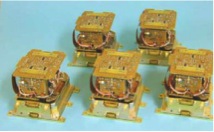Vapor cell Rubidium clocks
The main challenge for this type of clock is transportability, with strong constraints in terms of volume, mass, power consumption, cost and lifetime.
An integrated cell in a resonant microwave cavity contains rubidium atoms which interact simultaneously with the microwave radiation from the oscillator and the optical radiation used both for the optical pumping and for the clock signal detection. This detection is carried out by measuring the absorption, by the cell atoms, of the optical radiation generated by a lamp rubidium spectral. The absorption signal amplitude depends directly on the tuning with the microwave signal resonance injected into the resonant cavity. In order to suppress the first-order Doppler effect due to atom movements in the cell, a buffer gas is added into the cell to reduce, thanks to multiple collisions, the rubidium atoms moving area, thus allowing to be placed in the Lamb-Dicke regime.
Thanks to their strong technological maturity, reliability and good compromise between performance/size/cost, vapor cell rubidium clocks are today the most manufactured atomic clocks in the world (several thousand units per year), with varied applications on the ground and in space. For example, these clocks are installed in the GNSS constellations satellites, and in particular GALILEO, for the reference local time generation.
Vapor cell rubidium clocks are mainly limited by the systematic effects linked to collisions with the buffer gas (which strongly depends on the pressure and therefore on the temperature of the cell) and the light displacement (strongly depending on the spectral lamp characteristics). Improvements can be made, on one hand by using buffer gases mixtures inducing collisional displacements whose thermal sensitivities compensate each other.
Several laboratories are developing new configurations of high-performance vapor cell rubidium clocks with frequency stabilities target of 10-13 seconds. The solutions explored are:
- spectral lamp replacement by a laser to improve the signal-to-noise ratio and the optical pumping phenomena control in a rubidium clock;
- the Ramsey type atoms pulsed interrogation in a rubidium clock or in a coherent population trapping clock to refine the resonance line and reduce the light displacement phenomenon.

